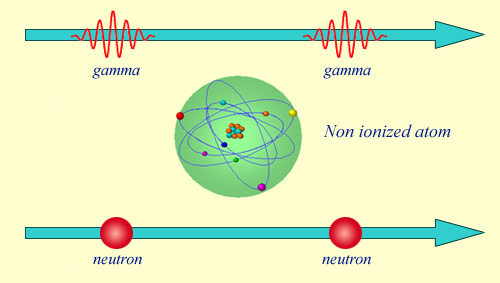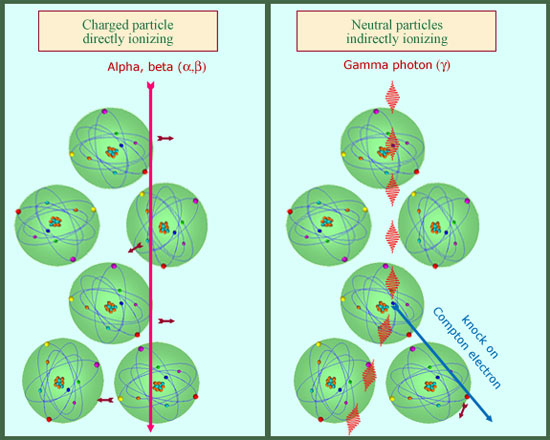Neutral Particle Effects
Energy transfer by proxy…
Neutral particles that are of interest in the field of radioactivity are gamma photons, neutrons produced in the core of nuclear reactors and neutrinos. They do not ionize and do not lose their energy gradually. On the other hand, to transmit their energy to the medium they can interact or set in motion other particles.

Neutral particles do not ionise directly
As opposed to charged radiation, neutral gamma rays and neutrons cannot eject electrons out of their atoms through ionization. Their lack of electric charge means that they have no such ionising ability, and can only interact over very short distances: gamma rays with electrons or nuclei and neutrons exclusively with nuclei.
IN2P3
Gamma photons interact essentially with the electrical charges of atoms.
Neutrons are nucleons that do not feel these electric charges but can be captured by nuclei and trigger nuclear reactions such as nuclear fission.
Neutrinos are so weakly interacting that they are very difficult to detect. Practically invisible, they have a negligible effect on matter and it is therefore so easy to protect ourselves from them that we can ignore their existence..

Indirect energy deposit
Charged particles – whether alpha, beta, or fission products – continuously deposit their energy in the mediums they cross by pulling electrons away from the surrounding atoms (left). The energy exchange takes place directly. In the case of gamma photons, no energy is lost until the photon interacts with an electron through a photoelectric or here Compton effect (right). This interaction causes this electron to move, ionize atoms and deposit energy; this indirect motion is the way neutral particles lose their initial energy.
© IN2P3
A gamma photon has the same nature as visible light. As long as the photon does not undergo a collision with an electron or a nucleus, it does not lose energy in the medium it passes through. It also causes no damage. Whent it interacts, however – generally with an electron or an atom – it transfers most or all of its energy to the medium via three processes which either eject an electron away from its atom (photoelectric and Compton effects) or create a new electron and positron (pair production). These three processes are the photoelectric effect, the Compton effect and the pair production effect.
Once these electrons start moving, they lose their energy and slow down like any other charged particle. Somehow, a gamma photon outsources to these particles set in motion the task of transferring its energy to the medium. Not very localized (and therefore highly diffuse in space), it is impossible to predict where the transfer of energy will take place contrarily to the case of alpha or beta particles.
Still more unpredictable is the path of a neutron, the way in which it slows down and loses its energy. A neutron completely ignores the electrons it passes, interacting only with nuclear matter. It transfer its energy by knocking nuclei and setting them in motion. It can also be captured by nuclei, often inducing nuclear reactions. After capturing one neutron, stable nuclei may become radioactive.
Other articles on the subject « Radiations effects in matter »
Charged Particle Effects
A gradual loss and transfer of energy Alpha rays, fission products ; heavy, slow and ionizing par[...]
Alpha Rays in Matter
An atomic bulldozer, strongly ionizing along a very short path Alpha particles are simultaneously[...]
Beta Rays in Matter
Light electrons : a chaotic journey through matter Beta electrons and positrons have equal and op[...]
Bremsstrahlung
A relativistic phenomenon that applies to electrons and positrons… The phenomenon of bremss[...]
Cherenkov Effect
When an electron goes faster than light in air and water … The Cherenkov effect occurs when[...]
Cross Section
Cross section or the interaction probability of a particle Cross section is the name given by phy[...]
Gamma Rays in Matter
Gamma can be attenuated but never fully stopped The neutral gamma rays leave very different effec[...]
Photoelectric Effect
The most effective mechanism of photon absorption The photoelectric effect is the phenomenon that[...]
Compton Effect
Photons as projectiles and electrons as targets The Compton effect is the name given by physicist[...]
Macroscopic Effects
Effects on inert or organic matter The ionisation of atoms surrounding the trajectory of an alpha[...]